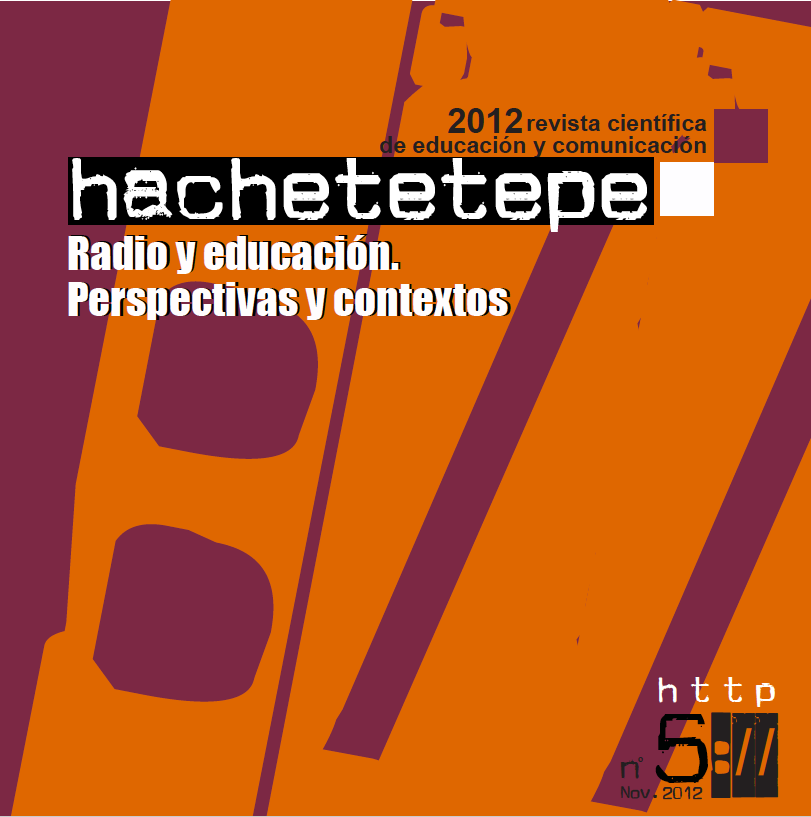The Interactive Public Service Digital Radio For New Multimedia Platforms, Transmedia and/or Hipermedia.

Info
Abstract
This proposal brings together diverse conceptual reflections and possible methodological actions to develop an interactive digital radio with multimedia, transmedia and/or hypermedia contents. This digital radio would be cognitive, informative and formative; it sets about to develop a new communicative experience for those existing broadcasters via AM, FM, OC hertzian waves, cable, satellite. Above all, this initiative would be transmitted via internet cyber radio.
Keywords
Downloads
How to Cite
License

This work is licensed under a Creative Commons Attribution-NonCommercial-NoDerivatives 4.0 International License.
Those authors who have published with this journal, accept the following terms:
- They will retain their copyright and guarantee the journal the right to first publication of their work, which will simultaneously be subject to the Creative Commons Attribution License . They may be copied, used, disseminated, transmitted and publicly displayed, provided that the authorship, url, and magazine are cited, and are not used for commercial purposes. No derivative works are allowed.
- They may adopt other non-exclusive license agreements for the distribution of the published version of the work (e.g., deposit it in an institutional telematic archive or publish it in a monographic volume) provided that the initial publication in this journal is indicated.
- Disseminate your work through the Internet (e.g., in institutional telematic archives or on your website) once the manuscript is accepted, which may lead to interesting exchanges and increased citations of the published work. (See The effect of open access).
Hachetetepé. Scientific journal of education and communication does not charge a fee for the submission of manuscripts or for the publication of its articles.
References
Asociación Mundial de Radios Comunitarias América Latina y Caribe (AMARC ALC) (1999). “La radio después de la radio. Buenos Aires, 2011”. Disponible en: http://sinca.cultura.gov.ar/archivos/documentacion/investigaciones/LRDdLR_e-book.pdf
Camacho, Lidia: La imagen radiofónica. Ed. McGraw-Hill, México, D.F. (Consultada 5 de mayo de 2012)
Cebrián Herreros, M. (1998). Información radiofónica. Mediaciónes, contenidos, expresión y aplicaciones. Madrid: Síntesis.
Cebrián Herreros, M. (2000). La radio en la convergencia multimedia. Barcelona, Gedisa.
Cebrián Herreros, M. (2007). Modelos de radio, desarrollos e innovaciones. Del diálogo y participación a la interactividad. Madrid: Fragua.
Cebrián Herreros, M. (2008). La radio en Internet. De la ciberradio a las redes sociales y la radio móvil. Buenos Aires: La Crujía.
Gómez, G. (2009). “La radio y la televisión en la era digital en AA.VV, Las mordazas invisibles. Nuevas y viejas barreras a la diversidad en la radiodifusión”. Buenos Aires, AMARC ALC. Disponible en: http://legislaciones.amarc.org (Consultada 5 de mayo de 2012)
Fidalgo, D. (2009). “Las radios universitarias en España. Transformación al mundo digital”, en Telas: Cuadernos de Comunicación e Innovación, 80; 124-137. Disponible en: http://sociedadinformacion.fundacion.telefonica.com/telos/articulodocumento.asp@idarticulo=2&rev=80.htm (Consultada 5 de mayo de 2012)
López Vidales, N. y Peñafiel Saiz, C. (2000). La tecnología en radio. Principios básicos, desarrollo y revolución digital. Bilbao: UPV/EHU.
López Vidales, N. y Peñafiel Saiz, C. (2002). Claves para la era digital, Evolución hacia nuevos medios, nuevos lenguajes y nuevos servicios. Bilbao: UPV/EHU., Bilbao, 2002.
Martín-Caro Sánchez, M. A. (2000). La radio del siglo XXI, un servicio público en la economía global. Madrid: Fragua.
Mcluhan, M. (1998). Comprender los medios de comunicación. Las extensiones del ser humano. Barcelona: Paidós.
Ortiz Sobrino, M. A. y López Vidales, N. (2011) (Ed.). Radio 3.0. Una nueva radio para una nueva era. Madrid. Fragua.

